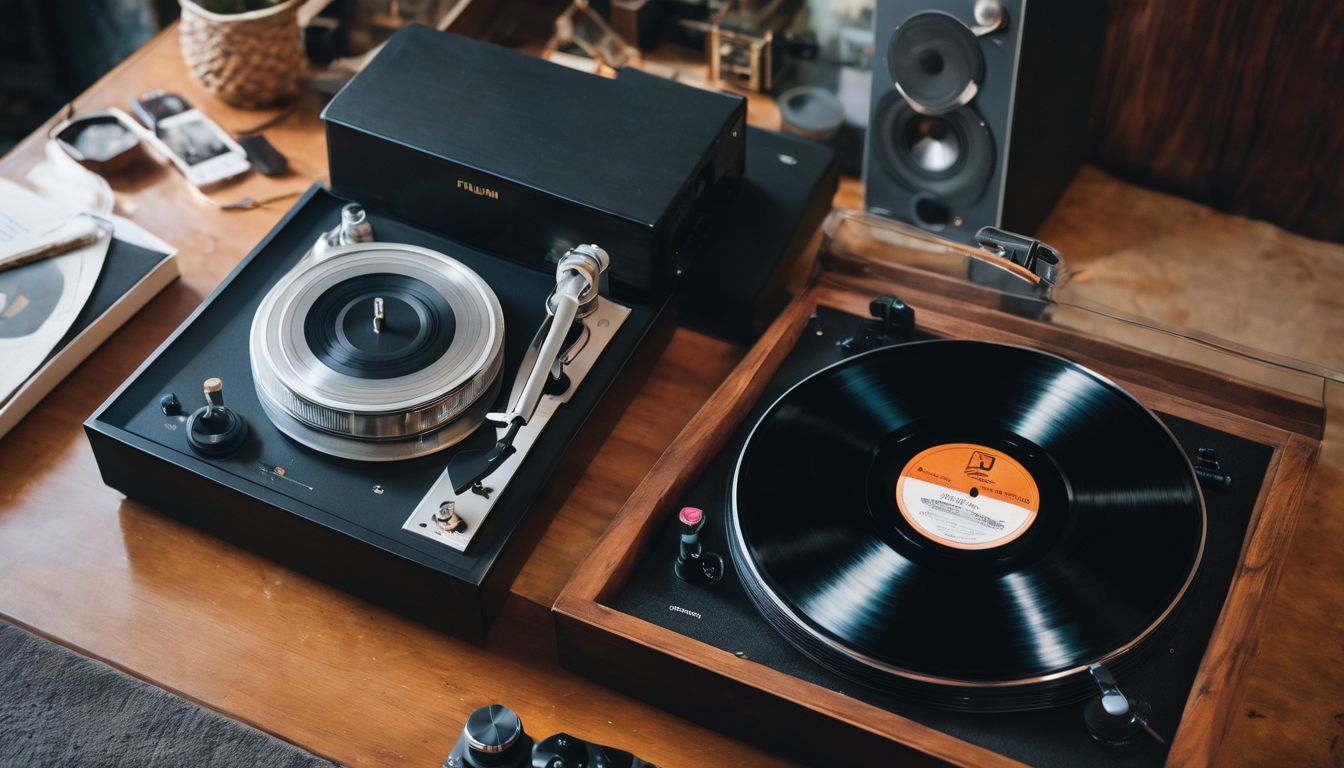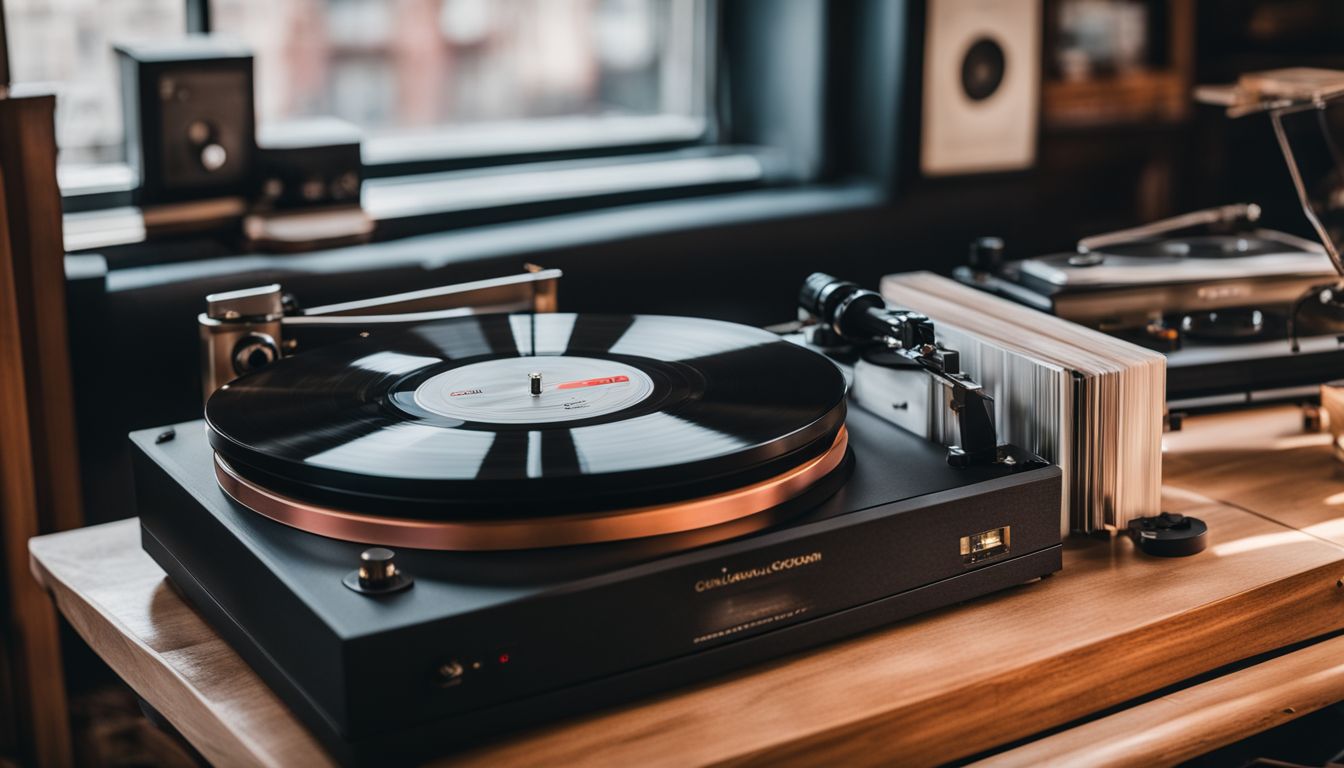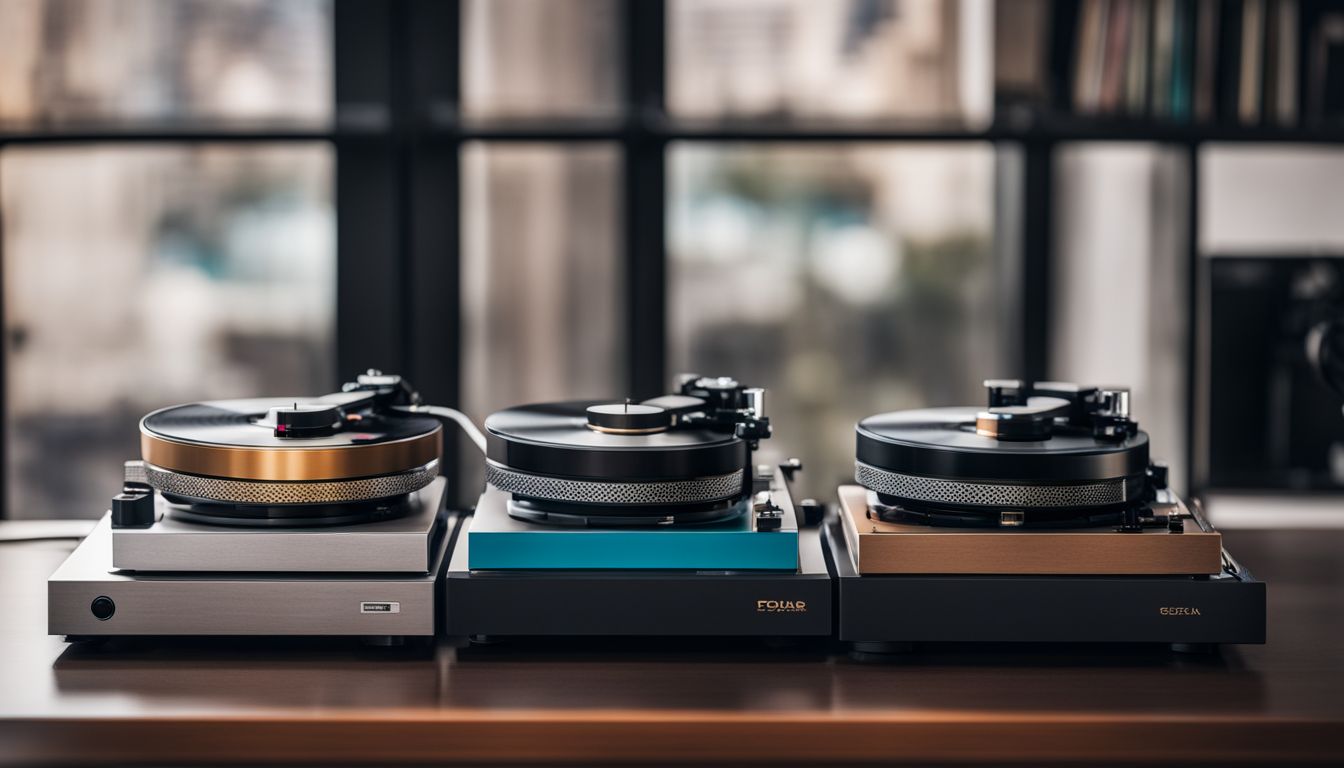Have you ever wondered how the music from your vinyl records transforms into the sound that fills your room? The magic begins with a small but critical component of your record player: the phono cartridge.
This article will journey through the inner workings of a cartridge turntable, making sense of its complex functions in simple terms. Discover the art behind audio with us!
Key Takeaways
- A phono cartridge is essential in transforming the movements of a stylus on vinyl records into an electrical signal for sound production. There are two main types: moving magnets (MM) and moving coils (MC), each with unique audio qualities.
- The stylus, or needle, comes in various shapes and directly affects sound quality through its ability to trace the grooves of a record. Cantilevers and suspension systems within cartridges ensure precise tracking and minimize unwanted vibrations.
- Different types of turntable cartridges offer options for all levels of audiophiles—from budget-friendly P-mounts suitable for beginners to high-end MC cartridges that capture subtle musical details for enthusiasts.
- Adjusting a cartridge’s azimuth is important for achieving accurate stereo imaging and preventing distortion; this fine-tuning allows the needle to sit at the correct angle relative to the vinyl grooves.
- Standard half-inch cartridges provide versatility across different turntables, allowing users to customize their listening experience with various stylus shapes and replacements tailored to personal preferences or DJ needs.
Understanding the Basics of a Cartridge Turntable
A cartridge turntable serves as the critical intermediary between your vinyl records and the rich sound they produce, converting minute grooves into an audible experience. It employs sophisticated mechanisms that respond to the intricate landscapes of a record’s surface, initiating a journey from physical etchings to audio signals.
What is a phono cartridge?
A phono cartridge, often known as the heart of a record player, transforms the physical movements of the stylus (needle) into an electrical signal. Mounted on the tonearm’s end, this tiny yet crucial device picks up vibrations from record grooves with absolute precision.
In essence, without it, your vinyl records would stay silent; its role is to serve as a transducer by converting mechanical energy into electric currents suitable for amplification.
Phono cartridges come in two primary types: moving magnets and moving coils. Each type has its own unique mechanism and audio characteristics that cater to different preferences and systems.
The moving magnet variant houses magnets attached to the stylus while coils remain stationary within the cartridge body. On the other hand, in moving coil designs, mobile coils are connected directly to the stylus while magnets remain fixed in place.
This design difference impacts factors like tracking force and frequency response, which subsequentlyaffect thes sound quality experienced through speakers or headphones.
How a Cartridge Works
At the heart of every turntable cartridge is a simple but ingenious process: translating vibrations into sound. As the stylus, or needle, traces the grooves on a vinyl record, it picks up tiny modulations that correspond to music.
These vibrations travel through a component called the cantilever and reach either the moving magnet (MM) or the moving coil (MC). In an MM cartridge, this causes magnets attached to the end of the cantilever to move within coils of wire, creating an electrical current.
The wires in the tonearm then send this electrical current, which is eventually amplified into audible sound through speakers. MC cartridges work on a similar principle but flip this arrangement; rather than using magnets at their tips, they have coils directly attached that move inside fixed magnets.
Due to their design differences, MC cartridges often require additional amplification from a phono preamp or step-up transformer for optimal performance. Despite these different structures between MM and MC units, both types strive for precise translation from physical groove undulations to rich audio frequencies that fill your space with high-fidelity sound.
Different types of turntable cartridges
Exploring the realm of turntable cartridges reveals a spectrum of designs, each tailored to enhance the sonic fidelity of your vinyl experience. These variations cater to a range of preferences and setups, inviting both casual listeners and discerning audiophiles to discover their ideal match for optimal audio performance.
A Moving Magnet Cartridge
The tiny magnet attached to the end of the stylus in a moving magnet cartridge vibrates as it traces the grooves in a vinyl record. These vibrations change the magnetic field between two coils positioned inside the cartridge body, resulting in the creation of electrical signals that are then amplified for playback through speakers or headphones.
This type of cartridge is known for its user-friendly design, allowing for simple stylus replacements when needed.
Moving magnet cartridges strike an attractive balance, offering both quality sound and an affordable price point, making them a top pick for music lovers building their home audio systems.
They work well with various stereo components due to their high compatibility rate. Popular models like Audio-Technica AT91B and Ortofon 2M Red are examples of how these cartridges cater to both new audiophiles and seasoned vinyl enthusiasts who demand rich and dynamic audio without breaking the bank.
A Moving Coil Cartridge is a type of cartridge used in turntables.
While moving magnet cartridges are common and user-friendly, moving coil cartridges step up the game significantly for audio enthusiasts. These devices house finely wound wire coils attached to the stylus cantilever inside a tiny generator.
As the stylus navigates the grooves of a record, vibrations transmit through the cantilever, causing the coils to move within a magnetic field. This motion generates an electrical signal that later transforms into sound through speakers or headphones.
Moving-coil cartridges are known for their precise tracking abilities and exceptional audio quality. They typically come with high-quality styli like Shibata or Microline, which pick up subtle nuances in music that other cartridges might miss.
Due to their intricate design and superior sound reproduction, they often carry a higher price tag but offer audiophiles a long-lasting stylus life and an immersive listening experience like no other cartridge type can provide.
P-Mount Cartridges
P-Mount cartridges simplify the vinyl listening experience with their user-friendly design. They’re known for their quick setup, featuring four terminals that plug right into a tonearm’s end without fuss.
These cartridges are particularly popular among newcomers to record players or anyone seeking an option for easy maintenance. You can effortlessly swap out P-mounts without tools or extensive adjustments, making them a practical choice for casual listeners and dedicated audiophiles alike.
Manufacturers crafted P-mount cartridges to take the guesswork out of alignment and mounting pressure. Users just slide the cartridge into place, secure it with a single screw, and get ready to enjoy their favorite records.
This convenience comes without sacrificing sound quality—many P-mount options deliver clear audio that satisfies even discerning ears. Stress-free installation promises more time for enjoying music and less time for tinkering with equipment—a harmony that any music lover can appreciate.
Standard half-inch cartridges
Standard half-inch cartridges connect to the tonearm of a turntable with four distinct prongs, ensuring strong and stable playback. They are versatile components well-suited for a variety of audio setups and preferences.
Their universal design allows them to fit on most turntables, making them widely accessible for music enthusiasts looking to customize their listening experience.
These cartridges support different stylus shapes, such as conical, elliptical, and microline, each designed to trace the record grooves with precision and care. A diamond stylus is common among these options because it provides exceptional durability and sound fidelity.
DJs often favor MM cartridges equipped with spherical styli due to their robustness in handling heavy use during scratching and back-cueing. For analog aficionados seeking high-quality sound reproduction or wishing to extend the life of their collection by switching out worn needles, standard half-inch options provide ample opportunities for upgrades or replacements without needing an entire cartridge swap.
The components of a cartridge
Delving into the anatomy of a turntable cartridge reveals how intricate components, like the stylus and magnet, interact to transform grooves on vinyl into audio magic—continue reading for an in-depth exploration.
Stylus (Needle)
The stylus, or needle, serves as the turntable’s primary contact point with a record’s surface. It traces the grooves of vinyl records, translating their physical undulations into electrical signals.
Constructed in various shapes—including conical, elliptical, and more sophisticated types like fine-line and Shibata—each design caters to different audio fidelity needs and budget considerations.
A quality stylus picks up an extensive range of musical details from the vinyl, which significantly influences sound reproduction.
Choosing the right stylus shape is crucial for audiophiles seeking a specific listening experience. While a conical stylus is robust and cost-effective, it may not capture all the nuances on the record.
In contrast, options like Shibata or Microline styli offer heightened precision but come at a higher price. Next up, let’s delve deeper into how cantilevers and suspension systems work together with these intricate needles to produce high-quality sound.
Cantilever and suspension
Moving beyond the stylus, we encounter the cantilever, which plays a crucial role in translating the grooves of a record into sound. Made from aluminum alloy, this slender component connects directly to the diamond tip at one end and extends to the cartridge body on the other.
Its rigid yet lightweight structure is essential for precise tracking as it navigates the intricate patterns etched into vinyl.
The suspension system holds everything in balance. A rubber mechanism is typically featured in the suspension system to absorb vibrations and prevent them from reaching other parts of the turntable that can cause interference.
This clever design maintains fidelity from record groove to loudspeaker output without unwanted noise or distortion by sending only pure musical signals through your tonearms and amplifier.
Magnets and wire coils
Magnets and wire coils are fundamental components in the magic of sound conversion within a turntable cartridge. As the stylus traces the grooves of a vinyl record, it vibrates. The vibrations move the magnet, which is positioned closely to wire coils in moving-magnet cartridges or vice versa in moving-coil designs.
This interaction converts physical vibrations into an electrical signal, similar to the process that occurs inside a microphone, which can then be amplified and played through speakers.
To appreciate how delicate sounds are faithfully picked up from a spiraling groove on a slab of vinyl, it is crucial to understand this electromechanical dance. In moving coil cartridges, despite their minuscule size and complex manufacturing needs—hence their higher price—they excel at capturing audio nuances due to their low mass and high precision.
The resulting electrical current mirrors the original recording’s modulated grooves as it races through the wires, heading towards further electronic voyages like RIAA equalization before filling a room with music.
Understanding Azimuth in Cartridge Turntables
The azimuth of a cartridge turntable plays a crucial role in how the stylus interacts with the record’s grooves. The azimuth of a cartridge turntable determines the angle at which the needle sits relative to the vinyl surface, allowing it to pick up every nuance of sound etched into the disc.
A correctly set azimuth aligns perfectly perpendicular with the groove walls, leading to balanced channels and an accurate stereo image.
Adjusting this angle requires meticulous attention, as even slight deviations can cause distortion or channel imbalance. High-end turntables often feature adjustable arms that allow audiophiles to fine-tune their setup for optimal performance.
Mastering azimuth adjustment is key for DJs and music enthusiasts seeking premium sound quality, free from unwanted noise and interference.
Conclusion
Delving into the world of cartridge turntables reveals a fascinating blend of art and science. Your choice of stylus and cartridge type shapes every listening moment, transforming vinyl grooves into rich audio landscapes.
Whether you’re assembling a system on a budget or investing in high-end gear, understanding how cartridges work enhances your audio experience. Embrace the complexities of these electro-mechanical marvels to unlock the full potential of your record collection.
Keep exploring, upgrading, and enjoying the timeless journey through music that turntables offer.
FAQs
What exactly is a cartridge turntable?
A cartridge turntable is an electro-mechanical device that plays records; it uses components like a phonograph cartridge with either moving magnets or coils to convert the grooves on vinyl into sounds.
How does a phonograph cartridge work?
In a phonograph cartridge, the stylus moves within the record’s grooves and through a rubber suspension, causing magnets or coils inside to create electrical signals that are then amplified for listening.
Are there different types of styli for turntables?
Yes, there are various styles, such as elliptical and spherical styli; each shape interacts differently with record grooves, affecting sound clarity and detail.
Can you use any speakers with a cartridge turntable?
Cartridge turntables require speakers to produce sound, typically passive speakers connected via phono input; some may alternatively connect to powered studio monitors.
Why do people still use classic quadraphonic systems today?
Quadraphonic sound systems offer an immersive audio experience due to their unique four-channel setup, allowing listeners to enjoy music with richer depth not easily replicated by modern digital methods.


